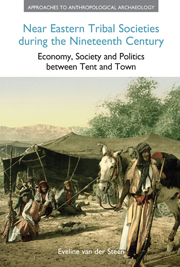 Near Eastern Tribal Societies during the Nineteenth Century
Near Eastern Tribal Societies during the Nineteenth Century We must have Blood, you know. Some young fellows, you know, may be a little behind their station, perhaps, in point of education and behaviour, and may go a little wrong, you know, and get themselves and other people into a variety of fixes – and all that – but deuce take it, it's delightful to reflect that they've got Blood in ‘em! Myself, I'd rather at any time be knocked down by a man who had got Blood in him, than I'd be picked up by a man who hadn't!
(Charles Dickens, David Copperfield)Introduction
The meaning of the word “ethnic” has changed substantially over time. During the nineteenth century, the science of ethnology referred to the concept of “race”. It was not until the 1950s that a group of internationally renowned sociologists signed a statement officially replacing the word “race” with “ethnic group”. During the nineteenth century, ethnic groups, or races, were seen as natural and unchanging, groups in which the members shared inherited traits. Each group had its place in the world order. Polygenists claimed different “races” had different origins, and therefore their place in the world order was hard and fast, assigned to them by their inheritance.
In 1925 Max Weber (in Wirtschaft und Gesellschaft) stated that ethnic groups are artificial constructs, created and maintained by a shared belief in common origins. Fredrik Barth (Ethnic Groups and Boundaries, 1969) pointed out that these beliefs and the way in which they create and maintain ethnic groups are continually renegotiated and reformulated to accommodate the changing environment or, rather, a changing population because a group's “ethnicity” (or any form of group identification) is only relevant in the confrontation or interaction with other groups.
To save this book to your Kindle, first ensure [email protected] is added to your Approved Personal Document E-mail List under your Personal Document Settings on the Manage Your Content and Devices page of your Amazon account. Then enter the ‘name’ part of your Kindle email address below. Find out more about saving to your Kindle.
Note you can select to save to either the @free.kindle.com or @kindle.com variations. ‘@free.kindle.com’ emails are free but can only be saved to your device when it is connected to wi-fi. ‘@kindle.com’ emails can be delivered even when you are not connected to wi-fi, but note that service fees apply.
Find out more about the Kindle Personal Document Service.
To save content items to your account, please confirm that you agree to abide by our usage policies. If this is the first time you use this feature, you will be asked to authorise Cambridge Core to connect with your account. Find out more about saving content to Dropbox.
To save content items to your account, please confirm that you agree to abide by our usage policies. If this is the first time you use this feature, you will be asked to authorise Cambridge Core to connect with your account. Find out more about saving content to Google Drive.